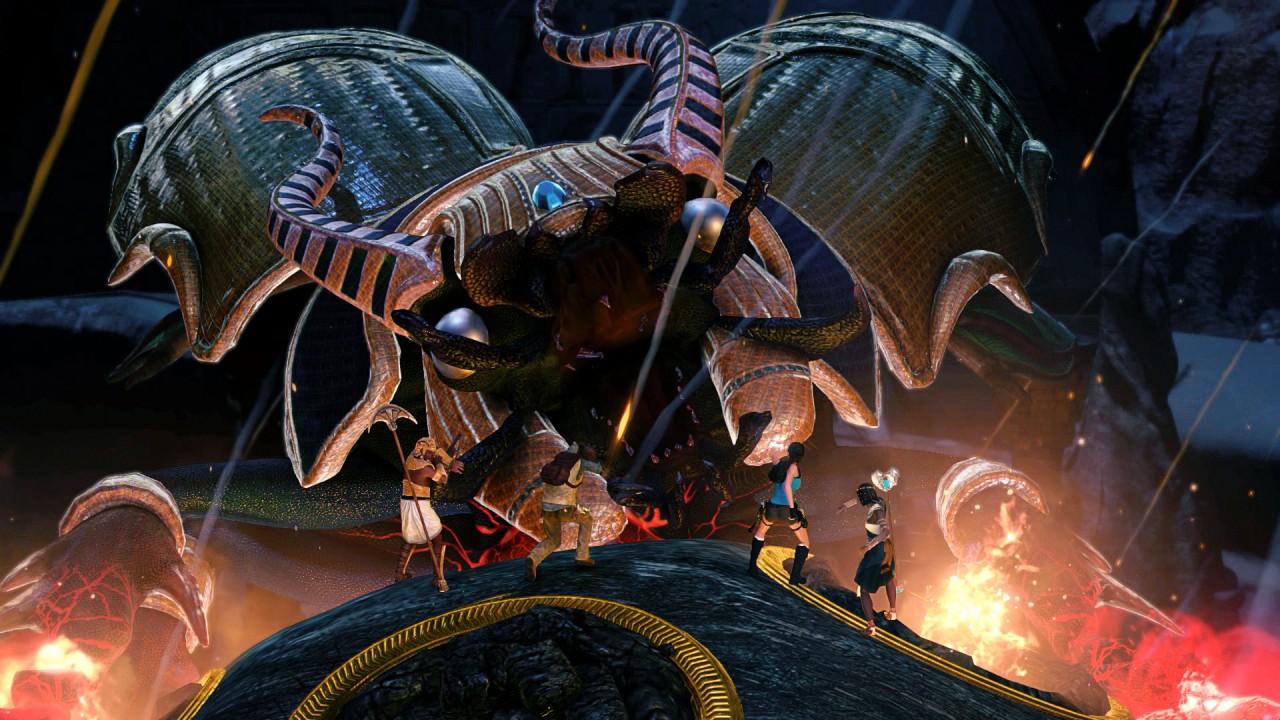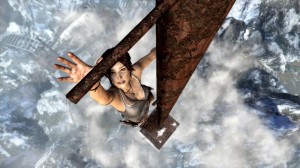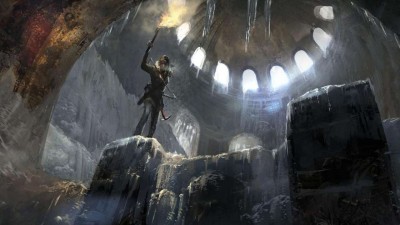Lara Croft has changed a lot over the years.
From the simplistic 540 polygon model used in the original Tomb Raider game, the character has gone through a vast number of makeovers and reboots since her 1996 debut - both technical, and in terms of her design and personality. Now, the character looks more lifelike than ever - with Square Enix having opting to use motion capture to create a much more realistic model in 2013’s rebooted version of series.
Although I loved the reboot (as did Wes Copeland in his Tomb Raider Review for Continue Play), I found that the charm of puzzles and, well, tomb raiding wasn’t quite as prominent. So when Lara Croft and the Temple of Osiris was announced, promising an experience much closer to how the original games worked and a sequel to the excellent Lara Croft and the Guardians of Light, I was curious to see exactly how accurate this promise was, and whether the developers had managed to successfully evoke the feeling of the classic games.
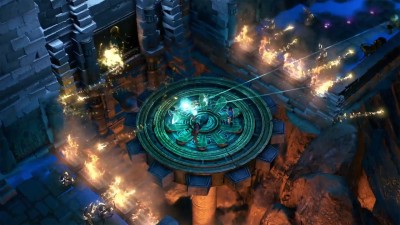 The story is fairly simple stuff. When Osiris, Egyptian God of the Afterlife, was murdered by Set, the God of deserts, storms, disorder and violence, his body was cut up and scattered into several pieces across the land. Lara teams up with Horus, the son of Osiris and Isis, to restore his father’s body and bring him back to life. Yes, you’re playing alongside an actual Egyptian God. Best not to think too hard about it.
The story is fairly simple stuff. When Osiris, Egyptian God of the Afterlife, was murdered by Set, the God of deserts, storms, disorder and violence, his body was cut up and scattered into several pieces across the land. Lara teams up with Horus, the son of Osiris and Isis, to restore his father’s body and bring him back to life. Yes, you’re playing alongside an actual Egyptian God. Best not to think too hard about it.
As silly as the premise is, it aligns fantastically with Ancient Egyptian mythology and makes for a very interesting concept. There aren’t many games which come to mind which explore this aspect of mythology in quite the way that Temple of Osiris does. It’s a good drawing point for the game, and it’s clear that the developers have done their research to make it feel as accurate to mythology as possible.
If you’ve come to Temple of Osiris straight from 2010’s Lara Croft and the Guardian of Light, you’ll find yourself in familiar territory. At times, perhaps a bit too familiar. Although the setting is obviously different, the gameplay is still spread across a series isometric levels containing puzzles which adapt depending on the number of players within the game (a nice touch). These are punctuated by twin-stick shooting which, while feeling slightly improved over the previous offering, still doesn’t feel as compelling as it should. 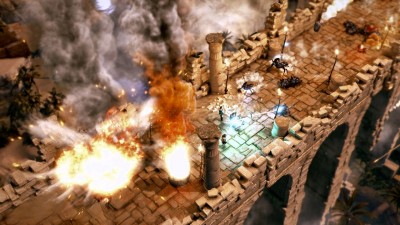 The controls could feel clunky at times, and it gets a little repetitive and predictable. Far too often, you’ll solve a puzzle only for waves of enemies to spill into a room. This isn’t helped by an uninspiring armory, with machine guns, shotguns and the usual standard fare spilling from broken pots and containing limited ammunition.
The controls could feel clunky at times, and it gets a little repetitive and predictable. Far too often, you’ll solve a puzzle only for waves of enemies to spill into a room. This isn’t helped by an uninspiring armory, with machine guns, shotguns and the usual standard fare spilling from broken pots and containing limited ammunition.
While the enemy designs are decent, a lack of variety means you’ll have seen pretty much every enemy type within the first couple of levels. Other than bosses, they only really come in four variants: scarabs, skeletons, crocodiles and these big exploding enemies which I’m not sure have an actual name. However, each of these types has a array of different powers. Scarabs are individually weak, but tend to swarm in groups, which requires more firepower. There are also some which are followed around by a trail of fire, which can be devastating if you run into it. Skeletons can attack you with both melee and ranged weapons, and some come equipped with a shield. Crocodiles can appear simply as aggressive creatures in the water, to more anthropomorphic creatures that need bombs to kill them. Different mixes of enemy types and numbers require some tactical maneuvering, but not enough that the gunplay ever feels particularly challenging on anything but the hardest difficulty settings.
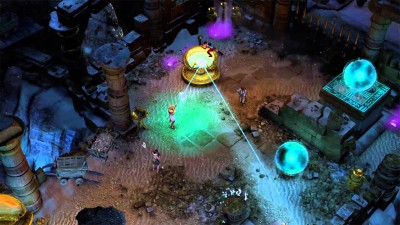 With slim pickings on offer when it comes to standard enemy types, it falls to the boss battles to mix things up a bit. Sadly, these encounters are a bit hit-and-miss. While there’s plenty of creativity on show in their visual design, there’s less to be excited about when it comes to how these encounters actually play out, and an inconsistent level of challenge.
With slim pickings on offer when it comes to standard enemy types, it falls to the boss battles to mix things up a bit. Sadly, these encounters are a bit hit-and-miss. While there’s plenty of creativity on show in their visual design, there’s less to be excited about when it comes to how these encounters actually play out, and an inconsistent level of challenge.
Some take mere moments to take down, whereas others can take an abundance of deaths and respawns before they finally bite the dust. Others are merely set pieces, forcing you to run into the screen across crumbling bridges in order to escape their wrath. Moments like these cause problems with Temple of Osiris‘ longevity and some of the set pieces feel rushed, shoehorned in at the last minute simply to serve as a climax to a level.
One of the best bosses in the game is found in the Tomb of the Pharaoh at around the halfway mark. Although the dungeon itself isn’t long at all, the encounter at the end makes up for it. The Pharaoh utilizes his environment to attack as well as melee, and it’s a high-point in the campaign. Attempting to defeat him is just on the right side of challenging, as you attempt to remain standing and deal damage, whilst also trying to dodge out of the way of the minion he summons into the arena. It’s a stand-out moment in an otherwise fairly humdrum experience.
Despite these rough edges, Temple of Osiris really shines as a multiplayer game. Up to four players can take part at any time, either in the comfort of your living room or online. There are four different characters to choose from, although someone must always be playing as Lara. Carter, a fellow archaeologist, is an option, as well as the Egyptian gods Horus and Isis, who have slightly different abilities.
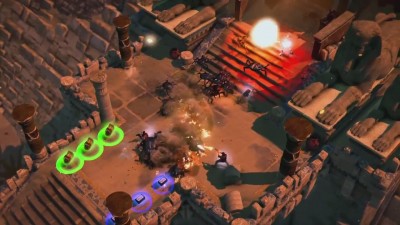 As previously mentioned, levels adapt to the number of players, requiring that you work together to navigate through each area. A puzzle which may have involved the player simply jumping from one platform to another in the single-player version of the game, becomes a puzzle where one player must use their grappling hook to create a rope bridge for the others to walk across, before grappling onto one of the players on the other side so they can get across before repeating the same process again in order to reach the objective.
As previously mentioned, levels adapt to the number of players, requiring that you work together to navigate through each area. A puzzle which may have involved the player simply jumping from one platform to another in the single-player version of the game, becomes a puzzle where one player must use their grappling hook to create a rope bridge for the others to walk across, before grappling onto one of the players on the other side so they can get across before repeating the same process again in order to reach the objective.
Playing with friends is just fun. It can become annoying when playing with strangers and one person feels the need to be as deliberately annoying as possible. Playing with your mates, and what would otherwise be frustrating instead becomes a source of hilarity. I lost count of the number of times I was crossing over somebody’s rope bridge before they broke away and let me fall to my death, or I was following other players on a jumping puzzle and they set a bomb exactly in the path I was needing to follow. It’s the same mischievous spirit that New Super Mario Bros. Wii U channeled, and it works just as well here as it did in that game.
On the visual side, things are competent but not blind-blowing, especially for the current generation. Admittedly, it’s difficult to make a graphically superior isometric game, and this is a budget download title as opposed to a full AAA release. Although it definitely looks nice, there’s nothing that really stands out. Unlike 2013’s Tomb Raider, there aren’t any real cinematics, with in-engine cutscenes simply serving the purpose of providing context for what’s going on. The best bits are the opening and closing scenes, which utilize a comic-book style of illustration, with subtle animation to the artwork. It’s an interesting aspect and makes for a short, but quite beautiful moment. If that same style had been adopted for the in-game action, then Temple of Osiris might have stood out a bit more in the visual stakes.
The sound work fares better. Sound is a prominent part of Temple of Osiris, and Crystal Dynamics has clearly put a lot of effort into this area. The music has obvious influences from Egyptian culture and sets the tone nicely. Dynamic changes to tempo let you know that there are enemies nearby, even if they haven’t appeared on the screen yet - a workaround given the limited viewing area, sure, but a welcome one. Once the music slows again, it’s your cue to take a breath, relax, and enjoy the light platforming and puzzling on offer.
Despite being mechanically quite different, Lara Croft and the Temple of Osiris is a great shout-out to the original games from the 90’s and evokes a wonderful sense of nostalgia for the feeling of adventure in Tomb Raider games gone by. Puzzles are welcome after the lack of them in the 2013 reboot, and it’s a nice return to journey through actual tombs (the reboot’s title really was quite misleading in that regard).
Although the longevity of the game and a middling single-player experience does prove to be an issue, get a few friends together for an evening and Temple of Osiris is a well-rounded, satisfying and enjoyable slice of co-op fun.
